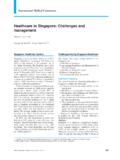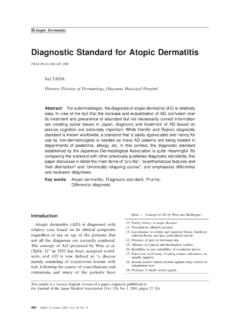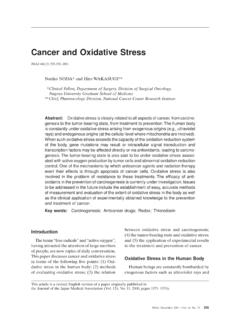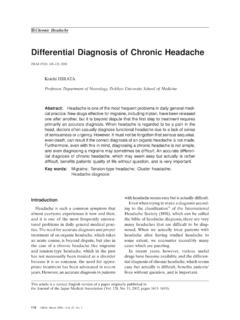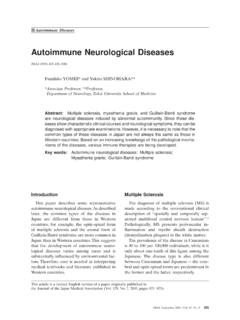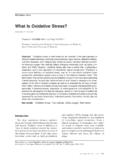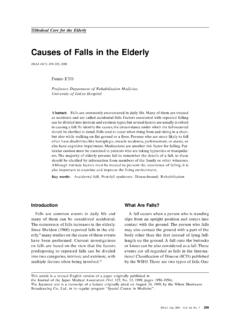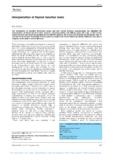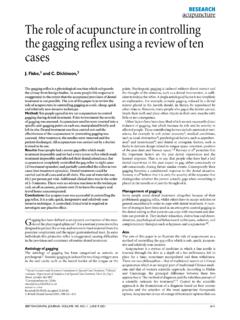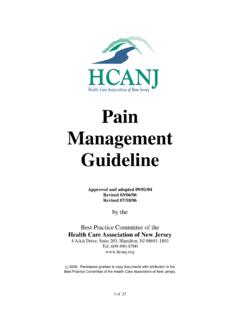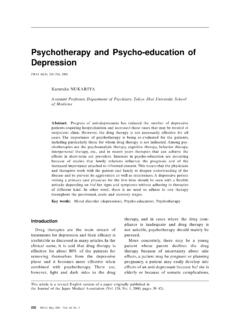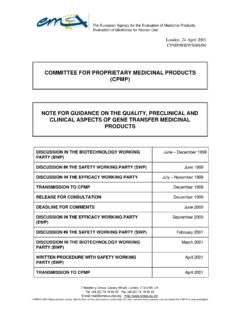Transcription of Depression and Suicide - Med
1 JMAJ, August 2001 Vol. 44, No. 8359 Depression and SuicideJMAJ 44(8): 359 363, 2001 Yoshitomo TAKAHASHIC hief, Department of Suicidology, Tokyo Institute of PsychiatryAbstract:Among the various mental disorders which tend to be closely relatedto Suicide , Depression is a particularly important risk factor. Many patients sufferingfrom Depression commit Suicide never having had access to psychiatric care orproper treatment. Although depressed mood, psychomotor retardation, anxiety,and autonomic symptoms may occur in Depression , patients suffering from depres-sion often visit a primary care physician rather than a psychiatrist, complaining ofvarious somatic symptoms. Therefore, the role of the primary care physician, notonly that of the psychiatrist, is critical in preventing such patients from committingsuicide. In this regard, the present report outlines means of assessing Suicide riskin depressed patients.
2 Since early diagnosis and implementation of intensive treat-ment for Depression provide a good chance of preventing Suicide , every physicianshould know how to assess the risk of words: Depression ; Suicide ; Risk factors; Accident-pronenessThis article is a revised English version of a paper originally published inthe Journal of the Japan Medical Association (Vol. 124, No. 1, 2000, pages 59 62).IntroductionAccording to statistics published by theNational Police Agency, 31,957 individuals com-mitted Suicide in Japan in 2000, a rate of 100,000 ) Among the causes ofsuicide, physical illness was the most common,accounting for of all suicides. Becauseof this close association with somatic illness,because individuals with psychiatric problemsoften visit a physician who does not specializein psychiatry, and because Depression is closelyrelated to Suicide and is associated with varioussomatic symptoms, general practitioners, notonly psychiatrists, play a significant role in pre-venting report focuses on assessment of the riskof Suicide in depressed patients.
3 Since earlydiagnosis and implementation of intensive treat-ment provide a good chance of Suicide preven-tion, it is important that every physician be wellinformed as to how to assess the risk of Picture of DepressionKielholz2) reported risk factors associatedwith Suicide in patients suffering from depres-sion (Table). These risk factors are describedbelow, with special emphasis on those possiblyrequiring particular )According to a survey done using the psy-chological autopsy method, 70 90% of those360 JMAJ, August 2001 Vol. 44, No. 8include persistent insomnia and extreme psycho-motor retardation and anxiety/irritability. Earlymorning waking is observed in most depressedpatients, and Suicide attempts are often madeat that time; thus, the highest priority should begiven to treating who are aware of feelings of despair,hopelessness, and worthlessness also requirespecial attention.
4 Certain researchers attachgreat importance to patients feelings of despairas a predictor of future Suicide rate in patients suffering fromdepression associated with delusions is ex-tremely high. Depressed patients sufferingfrom hypochondriacal delusion, delusion ofself-guilt, or delusion of poverty have a five-fold higher Suicide rate than those without )Some patients who have not yet reached thehypochondriacal delusion stage may dwell onsomatic symptoms. It is not rare for somaticsymptoms to be the most prominent featureY. TAKAHASHIwho committed Suicide had evidence of somemental disorder when alive, and 60 70% weredepressed. Reportedly, one in six patients whofall under the category of major Depression asset forth in the Diagnostic and StatisticalManual of Mental Disorders, 4th edition (DSM-IV), of the American Psychiatric Association,dies as a result of Suicide .
5 Thus, the Suicide rateamong patients suffering from Depression is atleast several dozen times higher than that ofthe general with severe Depression who meetthe diagnostic criteria for melancholia are atparticularly high risk of Suicide . Caution is alsonecessary in dealing with patients who are notseriously ill but have prolonged illnesses withrepeated exacerbations. Rapid cyclers, whoalternate between hypomanic and depressivephases within a short period of time, and patientswho present a mixed clinical picture in the con-valescent stage are also at high risk of that require particular cautionTable Risk Factors for Suicide in Depressed Patients (Kielholz, 1974)2)A) Signs of Suicide risk and selection of means1) Prior history of attempted Suicide or implication of suicide2) Family history of suicide3) Verbal threats of suicide4) Concrete disclosures as to preparation and implementation of suicide5) Unnaturally calm behavior after having been in an unstable state6) Dreams of self-destructionB) Specific symptoms1) Severe anxiety/irritability2) Persistent insomnia3) Uncontrollable aggressiveness4) Initial, convalescent, and mixed stages of depression5) Age periods associated with biological crisis (adolescence, pregnancy,puerperium, climacterium)6)
6 Severe self-guilt feelings7) Incurable illness, hypochondriacal delusion8) Concomitant alcohol dependencyC) Environmental factors1) Broken family2) Loss of someone or something important3) Occupational and financial difficulties4) Failure to carry out tasks or reach life goals5) Loss of religious affiliationsJMAJ, August 2001 Vol. 44, No. 8361 Depression AND SUICIDEof the patient s clinical picture, while otherdepressive symptoms remain relatively patients are apt to focus exclusively ontheir somatic symptoms and visit primary carephysicians other than patients in particular often complainof somatic symptoms, rather than reportingdepressed feelings. The leading cause of suicidein the elderly is physical illness. Although somehighly suicidal patients may have a malignantdisease with a poor prognosis, the presence of anumber of somatic symptoms, no one of whichis particularly severe, should also be regardedas a risk factor for ,6)It has been widely observed in the clinicalsetting that patients in the early stage ofdementia are often depressed.
7 Combined withinappropriate cognition of their surroundings, Depression in such patients may engender feel-ings of hopelessness. Even seemingly smallinabilities can suddenly create an imminentrisk of committing is also danger when disturbance ofconsciousness associated with some organicdisorder is concomitant with a depressive resembling an accident may occurunder the influence of delirium. In particular,when elderly patients who have tended to bedepressed for a long period develop milddementia or delirium as well, the risk of suicideincreases and particular caution is can be said that the 3Ds, namely, Depression ,mild dementia, and delirium, form a suiciderisk triad in the of IllnessIn regard to the relation between stage ofillness and Suicide risk, it is noteworthy thatrisk may increase abruptly just after onset, inconvalescence, and just after discharge fromthe hospital.
8 Of course, this does not apply toall patients, and Suicide risk should be carefullyassessed in every stage of ldinger7) classified the process leading tosuicide into three stages: a) thinking, b) ambiva-lence, and c) decision making. A certain periodof calm, like the calm before the storm , oftencharacterizes the decision-making stage. Thiscan be a dangerous time, possibly with impor-tant implications for treatment. It may happenthat a patient who has been depressed andsuffering extreme anxiety becomes peaceful,smiles, and shows gratitude to health care pro-viders, with a seemingly sudden disappearanceof earlier symptomatic behavior. Because ofthis period of calm, health care providers mayarrive at the optimistic conclusion that thepatient s Suicide risk has disappeared, whenthis is actually far from the Ideation, Suicide Attempt,and Family History of SuicideAny threats or actions that imply suicideshould be given serious consideration.
9 Theexpression of suicidal ideation is not limitedto words alone, and may be conveyed througha medium other than speech. Patients maydirectly say I want to die or I am going tokill myself . They may also express themselvesindirectly, making statements such as Life hasno meaning or I wish I would never wakeup . Another possibility is saying somethinglike Thank you for all you have done for me ,in an unnatural situation. Before committingsuicide, patients may dispose of or give awayvaluable possessions; they may prepare themeans to be used in Suicide ; or they may visitthe place where they plan to commit comparison with the general population,those who have survived a Suicide attempt arefar more likely to repeat suicidal behavior andto actually succeed. One in ten patients with ahistory of attempted Suicide does ultimatelysucceed in committing Suicide .
10 The Suicide riskis several hundred times greater among thesepatients than in the general population, indi-cating a history of attempted Suicide to be anextremely important risk factor. Patients whohave a history of self-injury or self-mutilation,such as taking a slight overdose of pills or cut-362 JMAJ, August 2001 Vol. 44, No. 8ting their wrists, are also at high risk of suicidein the long patients suffering from depressionattempt Suicide during treatment, they mostfrequently use prescription drugs. Therefore,it is important that neither hypnotics nor anti-depressants be prescribed at a potentially fataldose or that the patient s family assume theresponsibility for drug management. Particularcaution is warranted in the case of tricyclicantidepressants, which are dangerous becauseof their highly adverse effects on the is also important to obtain information asto the patient s family history of Suicide .
